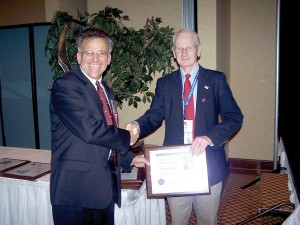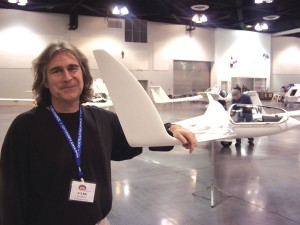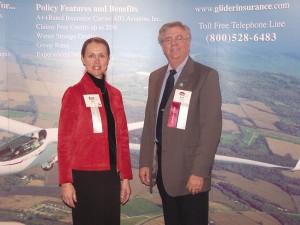By Ray Davids

Dean Carswell (right) presents the SSA Henry Combs trophy to Michael Koerner (left) for the greatest number of straight out diamond distance soaring flights.
Virtually all human beings, children and adults alike, have dreamed of flying like a bird, or like Peter Pan or Tinker Bell. Many make that dream a reality; more than 12,000 Americans soar like eagles and hawks over our land every year, all year long. From February 9 through 12, soaring achievements were celebrated in Ontario, Calif., at the 2005 Soaring Society of America Convention & Air Expo.
To soar is to rise or fly high into the air in an engineless glider, which soaring enthusiasts call a sailplane. SSA represents those who participate in soaring with sailplanes, motorgliders, and paragliders. Founded in 1932 in New York City, SSA is now headquartered in Hobbs, N.M., but soaring takes place all over the country.
This year’s convention got started with a free half-day “Soaring Software Academy.” Held at the Doubletree Hotel in Ontario, the academy was presented by developers of flight management and desktop software for pilots who use, or are contemplating buying, cockpit PDAs, pocket PCs, for navigation and flight analysis.
Miniaturization of powerful computer systems have enabled the cockpits of modern sailplanes to incorporate capabilities rivaling larger aircraft to aid not only navigation but also analysis of lift, best speeds to fly for maximum distance and final glide distances. They also provide for on-board recording and capability for downloading of data to ground computers for evaluating competitions and post-flight analysis of performance.
In the Ontario Convention Hall, soaring champions and notables gave 45 presentations over a three-day period, including Henry Combs, who spoke on Thursday, describing how he has enjoyably flown 205 Diamond distance flights in his single-seat Libelle sailplane.
The SSA and the Fédération Aéronautique Internationale define Diamond distance as 500 kilometers (310.7 miles) or greater for which achievement badges are awarded. Combs is one of 12 pilots who have also won the newly established World Distance Award for cumulative cross-country soaring distance equal or exceeding the circumference of the earth of 40,000 km (24,855 miles).

Jim Payne, Global Hawk flight test deputy manager, with the help of his wife Jackie, has amassed 4,300 hours in sailplanes earning three diamonds, a 1,000 km diploma, a world distance award, 57 U.S. national and six world records, the Eaton trophy and the
In fact, he has “won” it almost five times over, having flown more than 122,000 miles in a sailplane. He has soared up and down and across California, mostly from Crystal Airport in Llano, frequently leading an entire gaggle of pilots in their sailplanes as informal members of what is known as the Crystal Squadron. He said he didn’t have much enthusiasm for “out-and-return” flights, because “you could have got there without even leaving.” He preferred to discover how far he could go and find new places to land.
George Moffat, who won two successive Open Class World Soaring Championships in 1970 and 1974, described the first World Soaring Contest (his first win) held in the U.S., in Marfa, Texas, which was attended by Neal Armstrong one year after his landing on the moon. Moffat also authored “Winning on the Wind” in 1974, which many soaring pilots have studied to hone their own skills. “Winning II” is soon to be released for publication by Tom Knauff of Knauff & Grove.
Friday opened with a presentation to over 100 attendees of “In the Middle of Nowhere: Pilot and Crew Survival” by Jim Payne, a retired USAF lieutenant colonel, jet fighter pilot and former deputy commander of the Edwards Air Force Base Flight Test Operations Group. Significantly, Payne has set seven world soaring speed records, one of which was at 146.2 mph over a 100-kilometer triangular course.
After sailplane pilots take off, there’s always the possibility of having to “land out,” if they can’t find any lift. Rarely is an airport close by, so they may wind up in a desert, forest or mountains, with their ground crew searching for them. Payne described the Air Force’s Survival Training Guide and techniques for surviving extreme land-out conditions.
Friday morning, Kempton Izuno gave an erudite and exciting talk on his Sierra Wave “high risk soaring,” with outstanding pictures of the Sierra Nevada ridge from just under 18,000 feet, as he blasted along at 120 mph for over 1,023 miles in his ASH-26E self-launching sailplane. Following his talk, Mike Koerner, holder of the U.S. national distance record of 902 miles, from California City to Seminole, Texas, in 1984, described making 12 Diamond distance flights last year with the Crystal Squadron.

Mike Melvill and Steve Fossett share a common interest in soaring high above the earth over great distances.
That afternoon, Dr. Paul B. MacCready Jr., world-renowned physicist and winner of the 1956 Open Class World Soaring Championship in France, gave a talk on “The Present and Future of Elegant Soaring.” MacCready conceived, designed and developed the Gossamer Condor, the first human-powered aircraft, which won the Kremer prize of $95,000 in 1977. He also designed the Gossamer Albatross, which was pedaled over the English Channel from France to England, to win the second Kremer prize of $200,000 for human-powered flight, in 1979.
In 1981, MacCready built the sun-powered Solar Challenger, with over 16,000 solar cells mounted on its wings producing three kilowatts of power. It was flown across the English Channel in 5 hours and 23 minutes. A proponent of “doing more with less,” in 1971, MacCready founded AeroVironment, Inc., a high-tech company located in Monrovia and Simi Valley, Calif., which has produced the series of Gossamer human- and solar-powered aircraft, and other advanced technological concepts. Currently, AeroVironment’s Helios unmanned solar aircraft, with a wingspan of 247 feet, has flown to an altitude of 96,863 feet, setting a new world altitude record for both propeller and jet-powered aircraft. MacCready ended his talk by saying, “Soaring has shown the way to become more efficient in many ways, and is also just plain fun.”
At noon on Saturday, Einar Enevoldson, a longtime soaring pilot, former Air Force pilot and former NASA test pilot with considerable high altitude flight experience, and Dr. Elizabeth Austin, project meteorologist, described the Perlan Project. Steve Fossett and Enevoldson hope to set a new soaring altitude record of at least 62,000 feet in a highly modified Glaser-Dirks DG-505M glider. Their ultimate objective is to soar to 100,000 feet. Perlan is the Icelandic word for pearl; they hope to use the lift under polar stratospheric clouds, which are also called mother-of-pearl clouds.
The present record, set by Bob Harris in 1986 above the Sierra Nevada Mountains of California, is 49,009 feet. The Perlan Project has yet to determine where the team will stage next winter/spring season. It may be above the Andes of Argentina or possibly in New Zealand.
Fossett is probably best known for the first solo around-the-world balloon flight. He excels in the sport of gliding, where he has recently set world speed records for 500 km (triangle) and 1,000 km (out-and-return) flights. Recently, Fossett and Terry Delore of New Zealand claimed the world soaring distance record. On Dec. 4, 2004, they flew a Schleicher ASH-25M high performance sailplane along the Andes Mountains in Argentina. When certified by the FAI, the flight will be a new Free Distance World record of 2,187 kilometers (1,358 miles). The flight took 15-3/4 hours and covered a distance greater than that between Los Angeles and Minneapolis.
Exhibits

Greg Cole (right), Neva Cole (rear), and Doug Taylor (left) demonstrate how easy it is to lift the 155-lb. empty weight of the SparrowHawk carbon fiber sailplane offered by Windward Performance LLC.
There were 19 sailplanes and motorgliders, one hang glider, one partial ultra-light glider, two sailplane trailers and 65 exhibitor booths in the exhibit hall. It was a dazzling display of exotic sleek birdlike gliders ranging from an earlier Schweitzer 1-26 to a twin-jet self-launching sailplane, plus a sailplane simulator from Sky Sailing at Warner Springs, Calif., operated by Bret Willat, an air show glider aerobatic pilot.
Most high-performance gliders are manufactured in Europe, but Great Western Soaring at Crystal Airport has become the first distributor of the only sailplane presently manufactured in America, the Sparrowhawk, made by Windward Performance LLC in Bend, Ore. Fred Robinson, Diamond soaring pilot #80, also owner/operator of GWS, and Doug Taylor, one of the designers and builders of the Sparrowhawk, manned the GWS/Sparrowhawk booth.
The glider is unique in using a pre-impregnated resin carbon fiber structure that makes it extremely strong and light. It has a 37:1 glide ratio with only a 36-foot long wingspan and a built-in Ballistic Recovery System parachute. At a stated base price of $35,000, it’s one of the least expensive sailplanes available. Another unique feature of the Sparrowhawk is that by virtue of its structural material, it can be painted any color without concern for gel coat cracking or bubbling.
Gunter Voltz
Gunter Voltz is the latest enshrinee into the SSA’s Hall of Fame, honored for having soloed and gotten glider ratings for more than 400 soaring students. Now a resident of West Bend, Wis., Voltz was a sergeant in the Luftwaffe during World War II, flying a Fieseler Storch rigged as an ambulance plane at the Russian front.
“I made 25 to 30 takeoffs and landings every day carrying wounded German soldiers from the battlefields to rear hospitals,” he said. “The plane became very bloody.”
He came to the U.S. in 1951 with two children and added two more here. His youngest son graduated from the University of North Dakota, and is now an American Airlines captain flying out of Dallas. Voltz is 89 years young and still flies gliders, when his right knee isn’t bothering him too much.
Awards banquet
After the banqueters had finished dinner, Dean Carswell, chairman of the SSA, stated that 2,007 had attended the convention, the most ever so far in SSA history. More than 400 people showed up for the awards banquet, at which Michael W. Melvill, astronaut and glider pilot, was the guest speaker.

Professor Mark Maughmer shows his newly developed winglet design for the Schempp-Hirth Discus 2c advanced sailplane that has been recently flown by Helmut Treiber and Tilo Holighaus in Germany.
Melvill piloted SpaceShipOne on its first flight past the edge of space on June 21, 2004, winning the first commercial astronaut’s wings, and was also the pilot on SpaceShipOne’s first competitive flight for the Ansari X Prize competition.
SpaceShipOne is registered with the FAA as glider N328KF.
“I got my glider rating from Larry Barrett in Tehachapi, and my commercial glider rating in Minden, Nevada,” he said.
Originally from Durban, South Africa, Melvill came to the United States via England in the 1970s and became a U.S. citizen. He and his wife Sally have one son and four grandchildren.
He’s vice president and general manager of Scaled Composites, LLC, and has 24 years of experience as a test pilot. He’s logged nearly 7,000 hours in over 130 types of aircraft.
A longtime acquaintance of Scaled Composites founder Burt Rutan, Melvill has flown the first flights of nine of Rutan’s aircraft. He also built his own Long EZ aircraft, which he flew around the world in 1997 and is the only person other than Dick Rutan or Jeana Yeager to have piloted the Voyager aircraft that is now in the Smithsonian Air & Space Museum. He accompanied his clear description of launching into space with incredible pictures and video from inside and out of SpaceShipOne that thrilled an attentive and enraptured audience.
About SSA

Susan Fassett and Pat Costello, of Costello Insurance, based in Tempe, Ariz., which is one of the few brokers who will find insurance for gliders and motorgliders as well as club operations.
Of the 26 directors of SSA, 20 are elected from the various regions from coast-to-coast across the U.S. SSA sponsors training and competition contests, keeps records (member’s long distances, high altitudes, speeds), publishes the monthly magazine SOARING, and represents its members’ interests to government. C. Dennis Wright, the dynamic executive director, says SSA presently has 12,384 members, although there are over 39,000 pilots with glider ratings on their pilot certificates. The chairman of the organizing committee for this convention was Jim Skydell, the recently elected SSA Region 12 director.
If you weren’t at this convention, you missed a great event. However, if the concept of silent soaring of the sky grips your imagination and you’d like to learn more, visit www.ssa.org and explore its many links.

205 Diamond flyer Henry Combs alongside a 1939 Bowlus BA-100 Baby Albatross; William Hawley Bowlus was a progenitor of U.S. soaring and sailplanes.











